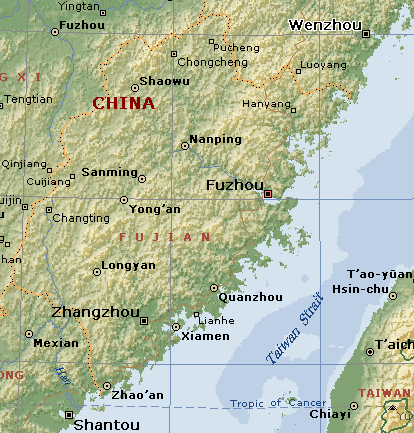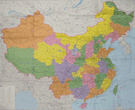|
|
|
Geography of Fujian |
Situated at
China’s southeast coast, Fujian Province lies west of Taiwan
Province. Separated only by a strip of water, Fujian and
Taiwan are regarded as sister province as their people are
joined by ties of blood and similar dialects. The province
covers an area of over 139,000 square kilometers and has a
population of 37.94 million (2022) of
Han,
She,
Hui,
Miao,
Manchu and
Gaoshan nationalities. The province capital is
Fuzhou.
|
|
|
Climate of Fujian |
Fujian has a mild and humid climate. Its mean temperature in the coldest
month of January is
5°C
(41°F) in the northwest and
12°C
(53.6°F) in the southeast. In the
hottest month of July, it has an average temperature of 25°C.-30°C
(77°F
- 86°F). Fujian
has abundant rainfall with an average annual precipitation of 800-1,900
mm, Summer and autumn is the typhoon season, which usually brings with
it torrential rain.
|
|
|
Brief History of Fujian |
Fujian is
called “Min” for short, which derived from the name of
Minzhongjun Prefecture set up by the First Emperor of the
Qin Dynasty some two thousand years ago after ha had unified
China. Five prefectures including the Prefectures of
Fuzhou
and Jianzhou were set up during the Tang Dynasty. In 733
A.D., the first character of these two prefectures were used
to name a newly-established military command, hence the name
of Fujian, which has since been in use. The period of the
Tang Song and Yuan Dynasties saw rapid development in
Fujian. It was during this period that Quanzhou became a
major trading part in China. It was also in that period that
Fujian saw the flourishing of culture and literature. Many
of the Province’s grand and elegant ancient buildings were
built during that period. Fujian was officially proclaimed a
province in both the Ming and Qing Dynasties.
|
|
|
Map of Fujian Province |
|

Map Source: MSN World Atlas |
|
|
Fujian Local Products |
Numerous
varieties of flowers and fruits abound in Fujian, its longan
production ranks first in the country. Lichee, orange,
banana, loquat, pineapple and olive are also widely grown.
Of all the flowers and plants in Fujian, well-known
Zhangzhou narcissuses come first on the list, and
sword-leave cymbidium is a close second. A major producer of
dried bamboo shoots; mushroom, silver agaric, rosin and herb
medicine in the country, Fujian is also one of the major
tea-producing provinces in China. Chongan Wuyiyan tea, Anxi
Tieguanyin, Fuzhou jasmine tea and Fu’an black tea are all
very famous. Fishery is very much developed along the coast.
Its lancelet is world-famous while its sea clam is widely
regarded as a delicacy. Fujian boasts numerous traditional
handicraft items, such as bodiless lacquer ware, shoushan
stone carving, cork carving, Dehua porcelain, Xiamen pearl
embroidery, Quanzhou puppets, Zhangzhou cotton picture and
Yongchun lacquer basket.
|
|
|
Fujian Local Cuisine |
|
Fujian
cuisine is characterized by its delicate sauces and
seasonings, its seafood variety, its punctilious selection
of ingredients and its careful preparation. In Fujian, the
dishes tend to be less oily, rare and spicy. The Juchunyuan
Restaurant is one of Fuzhou’s famous restaurants, capable of
fixing some two hundred famous dishes. First cooked with
some 20 principal ingredients including sea cucumber,
tendon, shark’s fin and abalone and over a dozen
complementary ingredients through hundreds of processes and
then brought, to a simmer in rice wine, the famous “Buddha
jumps over wall” is tender, delicious, beautiful decorated
and nutritious. Quanzhou’s Mantang Restaurant is widely
acclaimed for its chef’s super skill. The Xinmiaoxuan in
Xiamen is a specialty restaurant, where delicious yet light
dishes are served fresh with sweet, sour and spicy sauce.
The Southern Putuo Temple specializes in vegetarian dishes.
Both restaurant are widely known in Southeast Asia. |
|
|
Fujian Places of Interest and Tourist Attractions |
|
Fuzhou,
Xiamen, Quanzhou and Zhangzhou are open to foreign tourists.
Among them, Quanzhou has been listed a famous historic and
cultural city.
The
province capital of Fuzhou is a city with many historical
monuments. Surrounded by mountains, Fuzhou is also a
beautiful city astride the Minjiang River. The Drum Hill
suburban Fuzhou affords fine views of both the sea and
river, and is an ideal scenic spot for outing.
The
charming coastal city of Xiamen is famous for its mild
climate and exuberant flora. Gulangyu, a hilly islet to the
west of the city, fascinates people with its attractive
hillocks and grotesque rocks. From the hilltop is a sea of
red-tiled houses built on slope in ties, green trees and
bright-coloured flowers. No wonder it is called “a garden on
the sea” and “an island of music”. A highest point on the
islet, the Sunshine Rock, commands a good view of the sea
and the city. In Xiamen, other monuments worth visiting are
the Southern Putuo Temple, Jimei (a school village) and
Aoyuan, where Tan Kan Kee, a prominent patriotic overseas
Chinese, was buried.
Quanzhou,
an ancient city, in Fujian, has many historical sites like
the Kaiyuan Temple, built some 1,000 years ago, is well
known for the 24 statues of flying musicians carved on
pillars supporting the roof of its main hall. The upper part
of the statue is that of a woman and lower part that of a
bird, a masterpiece rarely seen in temple buildings across
the country. The two pagodas in the temple built over 700
years ago are the largest stone pagodas in the country.
Quanzhou’s Qingjing Mosque is one of the four oldest Islamic
sites in the country. Fondly called “country of narcissuses”
and “town of flowers and fruits”,
Zhangzhou
is world famous for its lichee, banana, longan and
narcissuses. Its narcissuses sell well in Southeast Asia and
West Europe.
Mount
Wuyi, listed among key scenic spots in the country, has been
lavishly praised by poets ancient and modern alike. The view
of its nine-zigzag stream and thirty-six peaks is just
breathtaking. Tourists can either climb to the top of Mt.
Wuyi to have a bird’s-eye view, or row down the stream on a
bamboo raft to enjoy the scenery alongside the stream. With
its picturesque mountain peaks and clear stream water, Mt.
Wuyi provides an attractive escape from the city life. |
|
|
|
|
|
Fujian Useful Links and Sites |
|
|
|
|
|
|
Fujian
Related Articles and Reports (Links) |
|
|
|
|
|
|
|
|
|
|




